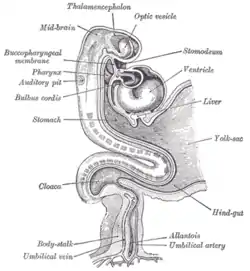Optic vesicle
The eyes begin to develop as a pair of diverticula (pouches) from the lateral aspects of the forebrain. These diverticula make their appearance before the closure of the anterior end of the neural tube;[1][2] after the closure of the tube around the 4th week of development, they are known as the optic vesicles. Previous studies of optic vesicles suggest that the surrounding extraocular tissues – the surface ectoderm and extraocular mesenchyme – are necessary for normal eye growth and differentiation.[3]
| Optic vesicle | |
|---|---|
 Transverse section of head of chick embryo of forty-eight hours’ incubation. (Optic vesicle labeled at lower right.) | |
 Human embryo about fifteen days old. Brain and heart represented from right side. Digestive tube and yolk sac in median section. (Optic vesicle labeled at center top.) | |
| Details | |
| Carnegie stage | 11 |
| Gives rise to | Human eyes |
| Identifiers | |
| Latin | vesicula optica; vesicula ophthalmica |
| TE | vesicle_by_E5.14.3.4.2.2.4 E5.14.3.4.2.2.4 |
| Anatomical terminology | |
They project toward the sides of the head, and the peripheral part of each expands to form a hollow bulb, while the proximal part remains narrow and constitutes the optic stalk, which goes on to form the optic nerve.[4][5]
Additional images
 Head of chick embryo of about thirty-eight hours’ incubation, viewed from the ventral surface. X 26
Head of chick embryo of about thirty-eight hours’ incubation, viewed from the ventral surface. X 26
See also
References
![]() This article incorporates text in the public domain from page 1001 of the 20th edition of Gray's Anatomy (1918)
This article incorporates text in the public domain from page 1001 of the 20th edition of Gray's Anatomy (1918)
Citations
- Hosseini, Hadi S.; Beebe, David C.; Taber, Larry A. (2014). "Mechanical Effects of the Surface Ectoderm on Optic Vesicle Morphogenesis in the Chick Embryo". Journal of Biomechanics. 47 (16): 3837–3846. doi:10.1016/j.jbiomech.2014.10.018. PMC 4261019. PMID 25458577.
- Hosseini, Hadi S.; Taber, Larry A. (2018). "How mechanical forces shape the developing eye". Progress in Biophysics and Molecular Biology. 137 (16): 25–36. doi:10.1016/j.pbiomolbio.2018.01.004. PMC 6085168. PMID 29432780.
- Fuhrmann, S. (2010). Eye Morphogenesis and Patterning of the Optic Vesicle. Current Topics in Developmental Biology Invertebrate and Vertebrate Eye Development, 61-84. doi:10.1016/b978-0-12-385044-7.00003-5
- Hosseini, Hadi S.; Beebe, David C.; Taber, Larry A. (2014). "Mechanical effects of the surface ectoderm on optic vesicle morphogenesis in the chick embryo". Journal of Biomechanics. 47 (16): 3837–3846. doi:10.1016/j.jbiomech.2014.10.018. PMC 4261019. PMID 25458577.
- Hosseini, Hadi S.; Taber, Larry A. (2018). "How mechanical forces shape the developing eye". Progress in Biophysics and Molecular Biology. 137 (16): 25–36. doi:10.1016/j.pbiomolbio.2018.01.004. PMC 6085168. PMID 29432780.
Sources
- Fuhrmann, S. (2010). Eye Morphogenesis and Patterning of the Optic Vesicle. Current Topics in Developmental Biology Invertebrate and Vertebrate Eye Development, 61–84. doi:10.1016/b978-0-12-385044-7.00003-5
External links
- eye-012—Embryo Images at University of North Carolina
- Overview at vision.ca
- Overview at temple.edu